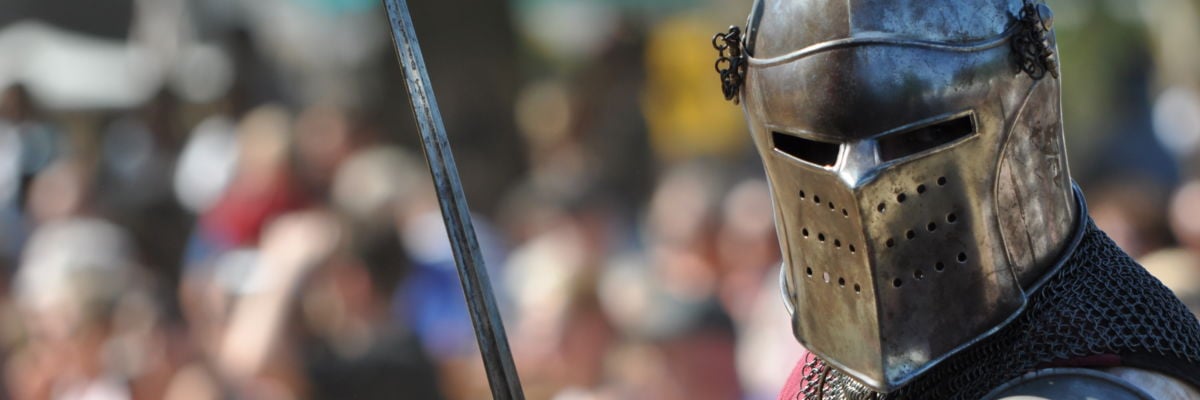
Controversy concerning sports mascots has been raging in our culture, with the latest example coming to us from Valparaiso, Indiana. Many groups have found certain mascots offensive due to pejorative racial or ethnic epithets, and the clamor to change these mascots to something more palatable to modern sensibilities has been growing.
This campaign has taken aim not only at professional sports franchises—the National Football League’s Washington Redskins, for example, changed its name last summer to the Washington Football Team—but also colleges and universities. In 2012, the University of North Dakota changed its name and mascot from the Fighting Sioux to the Fighting Hawks after an acrimonious process involving an official Nickname Committee and a period of time when the university’s sports teams were simply known as “North Dakota.”
The movement to change perceived offensive and derogatory mascots and nicknames includes campaigns targeted at the Christian past—most specifically, the use of the name Crusader. Under the influence of political correctness and a desire to be “tolerant” and “inclusive,” some colleges and universities are changing their Crusader mascots so as not to offend Muslim, Jewish, and even secular students, alumni, and benefactors. Valparaiso University, whose Crusaders will now be called the Beacons, is reacting to claims that “groups such as the Ku Klux Klan began using the words and symbols of the Crusades.”
Mascot controversies are by no means new. Over twenty years ago, the small evangelical Christian school Wheaton College, located outside Chicago, changed its longstanding nickname (since the 1920s) from Crusaders to Thunder out of a desire to distance itself from the negative connotations the medieval Crusades have for many people. College President Duane Litfin said the change was motivated by a recognition that the Crusades were “not very happy episodes in Christianity” and were “not something we want to glorify.”
Ironically, Wheaton College’s most famous alumnus, Billy Graham, became known worldwide for his “Billy Graham Crusades” evangelistic campaigns, which ran from 1947 to 2005, reaching more than 200 million people in 185 countries. Additionally, Wheaton College’s motto is “For Christ and His Kingdom,” a phrase that accurately captures the motivation of the medieval Crusaders.
In 2015, the small private liberal arts Susquehanna University (which began as the Missionary Institute of the Evangelical Lutheran Church in 1858), located in Selingsgrove, Pennsylvania, decided to replace its Crusader mascot, the school’s nickname since 1924. The university previously changed the personification of its mascot from a medieval knight to a tiger in a maroon cape known as the “Caped Crusader” in the 1990s.
University president L. Jay Lemon published an opinion piece in the Philadelphia Inquirer bristling at the criticism he’d received in some quarters for capitulation to political correctness. According to President Lemon, the main reason the school decided to change its mascot was the diversity among students on campus and student exposure “to different cultures and ideas through their travels,” particularly through the university’s Global Opportunities program.
Susquehanna University produced a video with commentary from President Lemon and Ron Cohen, vice president for university relations, along with a history lesson on the Crusades by Linda McMillin, provost and dean of faculty and history professor, to explain the rationale behind abandoning the Crusader nickname. Although the university was aiming for a transparent and inclusive mascot-changing process, it is disturbing to note that Professor McMillin’s lesson on the Crusades in the video is based on outdated and erroneous information. Most of her arguments appear based on the work of Sir Steven Runciman (1903-2000) and historians who still rely on his multivolume History of the Crusades, published in the 1950s.
Modern Crusade historians have thoroughly debunked Runciman’s work, which even at the time of publication was rooted in dated material and was nothing more than what Christopher Tyerman termed “a polemic masquerading as epic.” McMillin’s numerous errors on the Crusades include the following:
- the belief that they were systematic campaigns against the Jews and indigenous peoples in the Americas
- the promise of “guaranteed” admittance into heaven for those killed on Crusade
- that Crusaders participated for “wealth and glory” and were mostly second- and third-born sons looking for land
- that Christian holy war and Muslim jihad are fundamentally similar
- that the Crusades are the cause for modern-day tension among Islam and the West
McMillin echoes the familiar myths of the Crusades that began in the Protestant Reformation, were fostered during the Enlightenment, and were enshrined in the modern popular mindset by the secular media [1]. The Crusades were not directed at the Jewish people and were most assuredly not a systematic campaign akin to the Holocaust. Although some Crusaders, most notably Count Emich of Flonheim, participated in Jewish pogroms along the Rhineland in the late eleventh century, the Church never approved of their actions. Indeed, Catholic bishops in the cities attacked by these nefarious warriors protected the Jewish community through words and actions, including offering sanctuary on their own property.
The Church never taught that warriors who died on Crusade received guaranteed admittance into heaven. Although some believed at the time that the fallen warriors should be considered martyrs, the Church did not endorse this view. Bl. Urban II promised a plenary indulgence for those who participated in the First Crusade (subsequent popes did likewise for later Crusades), which was the main reason most people chose to participate in these armed pilgrimages. But an indulgence is the remission of the temporal punishment due to sin whose guilt has been forgiven in the sacrament of confession; it is not a “golden ticket” to heaven.
McMillin’s contention that the Crusades were an attempt by non-firstborn sons to gain land and wealth is a popular myth found in many history textbooks. However, the research of Jonathan Riley-Smith and others has shown that the overwhelming numbers of Crusaders were firstborn sons who stood to lose the most by going on Crusade. They went because noble families understood the importance of such a holy endeavor.
Viewing the Crusades through the eyes of the participants, with roots in authentic scholarship, leads one to embrace the name “Crusader” as a mascot and nickname. Deep faith in and love for Jesus and his Church were the primary motivators for most Crusaders. These were faith-filled warriors, willing to sacrifice their fortunes, families, and lives for the greater good of Christendom and the Church. They went on these campaigns out of love for God, the Church, their persecuted Christian brothers in the East, and concern for their own salvation. These self-sacrificial qualities should be at the center of collegiate athletics. Thankfully, there are institutions of higher learning that proudly utilize the Crusader mascot/nickname, including the College of the Holy Cross, Belmont Abbey College, Madonna University, and Christendom College.
An argument can be made for changing mascots and nicknames based on derogatory terms for a group of people, but doing so based on inaccurate history, especially by an institution of higher learning, is foolhardy. The decision by Valparaiso University (and others) to change their generations-old nickname highlights the need for an accurate understanding of the Crusades—a need that is imperative in our modern world.
[1] I have debunked these myths with recent scholarship from professional Crusade historians in my book The Glory of the Crusades as well as in previous blog posts.
Editor’s note: This is an updated version of “In Defense of the Crusader Mascot,” which ran on February 2, 2016.



